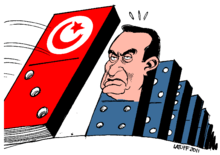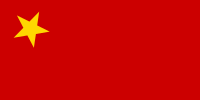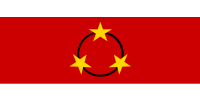Domino theory
The domino theory was a theory prominent from the 1950s to the 1980s that posited that if one country in a region came under the influence of communism, then the surrounding countries would follow in a domino effect.[1] The domino theory was used by successive United States administrations during the Cold War to justify the need for American intervention around the world.

U.S. President Dwight D. Eisenhower described the theory during an April 7, 1954, news conference, when referring to communism in Indochina:
Finally, you have broader considerations that might follow what you would call the "falling domino" principle. You have a row of dominoes set up, you knock over the first one, and what will happen to the last one is the certainty that it will go over very quickly. So you could have a beginning of a disintegration that would have the most profound influences.[2]
Moreover, Eisenhower’s deep belief in the domino theory in Asia heightened the “perceived costs for the United States of pursuing multilateralism”[3] because of multifaceted events including the “1949 victory of the Chinese Communist Party, the June 1950 North Korean invasion, the 1954 Quemoy offshore island crisis, and the conflict in Indochina constituted a broad-based challenge not only for one or two countries, but for the entire Asian continent and Pacific.”[3] This connotes a strong magnetic force to give in to communist control, where it aligns with the commentary by General Douglas MacArthur, that “victory is a strong magnet in the East.”[4]
Apart from President Eisenhower’s description, American academic Victor Cha also explained the domino theory in his book, titled Powerplay: The Origins of the American Alliance System in Asia. Cha analyzes the domino theory with close reference to Asia, where he states that "the fall of one small country in Asia could trigger a chain of countries falling to communism.”[3]
History
During 1945, the Soviet Union brought most of the countries of eastern Europe and Central Europe into its influence as part of the post-World War II new settlement,[5] prompting Winston Churchill to declare in a speech in 1946 at Westminster College in Fulton, Missouri that:
From Stettin in the Baltic to Trieste in the Adriatic an "Iron Curtain" has descended across the Continent. Behind that line lie all the capitals of the ancient states of Central and Eastern Europe. Warsaw, Prague, Budapest, Belgrade, Bucharest and Sofia; all these famous cities and the populations around them lie in what I must call the Soviet sphere, and all are subject, in one form or another, not only to Soviet influence but to a very high and in some cases increasing measure of control from Moscow.[6]
Following the Iran crisis of 1946, Harry S. Truman declared what became known as the Truman Doctrine in 1947,[7] promising to contribute financial aid to Greece during their Civil War and to Turkey following World War II, in the hope that this would impede the advancement of Communism into Western Europe.[8] Later that year, diplomat George Kennan wrote an article in Foreign Affairs magazine that became known as the "X Article", which first articulated the policy of containment,[9] arguing that the further spread of Communism to countries outside a "buffer zone" around the USSR, even if it happened via democratic elections, was unacceptable and a threat to U.S. national security.[10] Kennan was also involved, along with others in the Truman administration, in creating the Marshall Plan,[11] which also began in 1947, to give aid to the countries of Western Europe (along with Greece and Turkey),[12] in large part with the hope of keeping them from falling under Soviet domination.[13]
In 1949, a Communist-backed government, led by Mao Zedong, was instated in China (officially becoming the People's Republic of China).[14] The installation of the new government was established after the People's Liberation Army defeated the Nationalist Republican Government of China in the aftermath of the Chinese Civil War (1927-1949).[15] Two Chinas were formed - mainland 'Communist China' (People's Republic of China) and 'Nationalist China' Taiwan (Republic of China). The takeover by Communists of the world's most populous nation was seen in the West as a great strategic loss, prompting the popular question at the time, "Who lost China?"[16] The United States subsequently ended diplomatic relations with the newly-founded People's Republic of China in response to the communist takeover in 1949.[15]
Korea had also partially fallen under Soviet domination at the end of World War II, split from the south of the 38th parallel where U.S. forces subsequently moved into. By 1948, as a result of the Cold War between the Soviet Union and the U.S., Korea was split into two regions, with separate governments, each claiming to be the legitimate government of Korea, and neither side accepting the border as permanent. In 1950 fighting broke out between Communists and Republicans that soon involved troops from China (on the Communists' side), and the United States and 15 allied countries (on the Republicans' side). Though the war never officially ended, the fighting ended in 1953 with an armistice that left Korea divided into two nations, North Korea and South Korea. Mao Zedong's decision to take on the U.S. in the Korean War was a direct attempt to confront what the Communist bloc viewed as the strongest anti-Communist power in the world, undertaken at a time when the Chinese Communist regime was still consolidating its own power after winning the Chinese Civil War.
The first figure to propose the domino theory was President Harry S. Truman in the 1940s, where he introduced the theory in order to “justify sending military aid to Greece and Turkey.”[17] However, the domino theory was popularized by President Dwight D. Eisenhower when he applied it to Southeast Asia, especially South Vietnam. Moreover, the domino theory was utilized as one of the key arguments in the “Kennedy and Johnson administrations during the 1960s to justify increasing American military involvement in the Vietnam War.”[17]
In May 1954, the Viet Minh, a Communist and nationalist army, defeated French troops in the Battle of Dien Bien Phu and took control of what became North Vietnam.[18] This caused the French to fully withdraw from the region then known as French Indochina, a process they had begun earlier.[19] The regions were then divided into four independent countries (North Vietnam, South Vietnam, Cambodia and Laos) after a deal was brokered at the 1954 Geneva Conference to end the First Indochina War.[20]
This would give them a geographical and economic strategic advantage, and it would make Japan, Taiwan, the Philippines, Australia, and New Zealand the front-line defensive states. The loss of regions traditionally within the vital regional trading area of countries like Japan would encourage the front-line countries to compromise politically with communism.
Eisenhower's domino theory of 1954 was a specific description of the situation and conditions within Southeast Asia at the time, and he did not suggest a generalized domino theory as others did afterward.
During the summer of 1963, Buddhists protested about the harsh treatment they were receiving under the Diem government of South Vietnam. Such actions of the South Vietnamese government made it difficult for the Kennedy administration's strong support for President Diem. President Kennedy was in a tenuous position, trying to contain Communism in Southeast Asia, but on the other hand, supporting an anti-Communist government that was not popular with its domestic citizens and was guilty of acts objectionable to the American public.[21] The Kennedy administration intervened in Vietnam in the early 1960s to, among other reasons, keep the South Vietnamese "domino" from falling. When Kennedy came to power there was concern that the communist-led Pathet Lao in Laos would provide the Viet Cong with bases, and that eventually they could take over Laos.[22]
Arguments in favor of the domino theory
The primary evidence for the domino theory is the spread of communist rule in three Southeast Asian countries in 1975, following the communist takeover of Vietnam: South Vietnam (by the Viet Cong), Laos (by the Pathet Lao), and Cambodia (by the Khmer Rouge). It can further be argued that before they finished taking Vietnam prior to the 1950s, the communist campaigns did not succeed in Southeast Asia. Note the Malayan Emergency, the Hukbalahap Rebellion in the Philippines, and the increasing involvement with Communists by Sukarno of Indonesia from the late 1950s until he was deposed in 1967. All of these were unsuccessful Communist attempts to take over Southeast Asian countries which stalled when communist forces were still focused in Vietnam.
Walt Whitman Rostow and the then Prime Minister of Singapore Lee Kuan Yew have argued that the U.S. intervention in Indochina, by giving the nations of ASEAN time to consolidate and engage in economic growth, prevented a wider domino effect.[23] Meeting with President Gerald Ford and Henry Kissinger in 1975, Lee Kuan Yew argued that "there is a tendency in the U.S. Congress not to want to export jobs. But we have to have the jobs if we are to stop Communism. We have done that, moving from simple to more complex skilled labor. If we stop this process, it will do more harm than you can every[sic] repair with aid. Don't cut off imports from Southeast Asia."[24]
McGeorge Bundy argued that the prospects for a domino effect, though high in the 1950s and early 1960s, were weakened in 1965 when the Indonesian Communist Party was destroyed via death squads in the Indonesian genocide. However, proponents believe that the efforts during the containment (i.e., Domino Theory) period ultimately led to the demise of the Soviet Union and the end of the Cold War.
Some supporters of the domino theory note the history of communist governments supplying aid to communist revolutionaries in neighboring countries. For instance, China supplied the Viet Minh, the North Vietnamese army, with troops and supplies, and the Soviet Union supplied them with tanks and heavy weapons. The fact that the Pathet Lao and Khmer Rouge were both originally part of the Vietminh, not to mention Hanoi's support for both in conjunction with the Viet Cong, also give credence to the theory. The Soviet Union also heavily supplied Sukarno with military supplies and advisors from the time of the Guided Democracy in Indonesia, especially during and after the 1958 civil war in Sumatra.
Linguist and political theorist Noam Chomsky wrote that he believes that the domino theory is roughly accurate, although he put a more positive spin on the threat, writing that communist and socialist movements became popular in poorer countries because they brought economic improvements to those countries in which they took power. For this reason, he wrote, the U.S. put so much effort into suppressing so-called "people's movements" in Chile, Vietnam, Nicaragua, Laos, Grenada, El Salvador, Guatemala, etc. "The weaker and poorer a country is, the more dangerous it is as an example. If a tiny, poor country like Grenada can succeed in bringing about a better life for its people, some other place that has more resources will ask, 'Why not us?'" Chomsky refers to this as the "threat of a good example".[25]
Significance of the domino theory
The domino theory is significant because it underlines the importance of alliances, which may vary from rogue alliances to bilateral alliances. This implies that the domino theory is useful in evaluating a country’s intent and purpose of forging an alliance with others, including a cluster of other countries within a particular region. While the intent and purpose may differ for every country, Victor Cha portrays the asymmetrical bilateral alliance between the United States and countries in East Asia as a strategic approach, where the United States is in control and power to either mobilize or stabilize its allies. This is supported by how the United States created asymmetrical bilateral alliances with the Republic of Korea, Republic of China and Japan “not just to contain but also constrain potential ‘rogue alliances’ from engaging in adventurist behavior that might it into larger military contingencies in the region or that could trigger a domino effect, with Asian countries falling to communism.”[3] Since the United States struggled with the challenge of “rogue alliances and the threat of falling dominoes combined to produce a dreaded entrapment scenario for the United States,”[3] the domino theory further underscores the importance of bilateral alliances in international relations. This is evident in how the domino theory provided the United States with a coalition approach, where it “fashioned a series of deep, tight bilateral alliances”[3] with Asian countries including Taiwan, South Korea, and Japan to “control their ability to use force and to foster material and political dependency on the United States.”[3] Hence, this indicates that the domino theory assists in observing the effect of forged alliances as a stepping stone or stumbling block within international relations. This underscores the correlation between domino theory and path dependency, where a retrospective collapse of one country falling to communism may not only have adverse effects to other countries but more importantly, on one’s decision-making scope and competence in overcoming present and future challenges. Therefore, the domino theory is indubitably a significant theory which deals with the close relationship between micro-cause and macro-consequence, where it suggests such macro-consequences may result in long-term repercussions.
Applications to communism outside Southeast Asia
Michael Lind has argued that though the domino theory failed regionally, there was a global wave, as communist or Marxist–Leninist regimes came to power in Benin, Ethiopia, Guinea-Bissau, Madagascar, Cape Verde, Mozambique, Angola, Afghanistan, Grenada, and Nicaragua during the 1970s. The global interpretation of the domino effect relies heavily upon the "prestige" interpretation of the theory, meaning that the success of Communist revolutions in some countries, though it did not provide material support to revolutionary forces in other countries, did contribute morale and rhetorical support.
In this vein, Argentine revolutionary Che Guevara wrote an essay, the "Message to the Tricontinental", in 1967, calling for "two, three ... many Vietnams" across the world.[26] Historian Max Boot wrote, "In the late 1970s, America's enemies seized power in countries from Mozambique to Iran to Nicaragua. American hostages were seized aboard the SS Mayaguez (off Cambodia) and in Tehran. The Soviet Army invaded Afghanistan. There is no obvious connection with the Vietnam War, but there is little doubt that the defeat of a superpower encouraged our enemies to undertake acts of aggression that they might otherwise have shied away from."[27]
In addition, this theory can be further bolstered by the rise in terrorist incidents by left-wing terrorist groups in Western Europe, funded in part by Communist governments, between the 1960s and 1980s.[28][29][30] In Italy, this includes the kidnapping and assassination of former Italian Prime Minister Aldo Moro, and the kidnapping of former US Brigadier General James L. Dozier, by the Red Brigades.
In West Germany, this includes the terrorist actions of the Red Army Faction. In the far east the Japanese Red Army carried out similar acts. All four, as well as others, worked with various Arab and Palestinian terrorists, which like the red brigades were backed by the Soviet Bloc.
In the 1977 Frost/Nixon interviews, Richard Nixon defended America's destabilization of the Salvador Allende regime in Chile on domino theory grounds. Borrowing a metaphor he had heard, he stated that a Communist Chile and Cuba would create a "red sandwich" that could entrap Latin America between them.[31] In the 1980s, the domino theory was used again to justify the Reagan administration's interventions in Central America and the Caribbean region.
In his memoirs, former Rhodesian Prime Minister Ian Smith described the successive rise of authoritarian left-wing governments in Sub-Saharan Africa during decolonization as "the communists' domino tactic".[32] The establishment of pro-communist governments in Tanzania (1961–64) and Zambia (1964) and explicitly Marxist–Leninist governments in Angola (1975), Mozambique (1975), and eventually Rhodesia itself (in 1980)[33] are cited by Smith as evidence of "the insidious encroachment of Soviet imperialism down the continent".[34]
Other applications

Some foreign policy analysts in the United States have referred to the potential spread of both Islamic theocracy and liberal democracy in the Middle East as two different possibilities for a domino theory. During the Iran–Iraq War the United States and other western nations supported Ba'athist Iraq, fearing the spread of Iran's radical theocracy throughout the region. In the 2003 invasion of Iraq, some neoconservatives argued that when a democratic government is implemented, it would then help spread democracy and liberalism across the Middle East. This has been referred to as a "reverse domino theory,"[35] or a "democratic domino theory,"[36] so called because its effects are considered positive, not negative, by Western democratic states.
See also
References
- Leeson, Peter T.; Dean, Andrea (2009). "The Democratic Domino Theory". American Journal of Political Science. 53 (3): 533–551. doi:10.1111/j.1540-5907.2009.00385.x.
- "The Quotable Quotes of Dwight D. Eisenhower". National Park Service. December 5, 2013. Archived from the original on 2013-03-28. Retrieved 2013-12-05.
- Cha, Victor (2016). Powerplay: The Origins of the American Alliance System in Asia. p. 158.
- Extracts of Memorandum of Conversation by Mr. W. Averell Harriman, Special Assistant to the President, with General MacArthur in Tokyo, August 6 and 8, 1950, Top Secret, August 20, 1950 in FRUS, 1950, Vol. 7: Korea, p. 544.
- Mark Kramer (April 30, 2010). "STALIN, SOVIET POLICY, AND THE CONSOLIDATION OF A COMMUNIST BLOC IN EASTERN EUROPE, 1944-1953" (PDF). Stanford University. Archived from the original (PDF) on October 21, 2013.
- "The Iron Curtain: Winston S. Churchill, "The Sinews of Peace," speech, 1946". The International Churchill Society. 2017. Archived from the original on 2017-01-28. Retrieved 2017-01-09.
- Daniel S. Margolies (2012). A Companion to Harry S. Truman. pp. 372, 373. ISBN 978-1444331417.
- "The Truman Doctrine, 1947". United States Department of State Office of the Historian, Bureau of Public Affairs. December 5, 2013. Archived from the original on 2017-05-16. Retrieved 2017-06-14.
- "Kennan and Containment, 1947". United States Department of State Office of the Historian, Bureau of Public Affairs. December 5, 2013. Archived from the original on 2017-06-28. Retrieved 2017-06-14.
- Kennan, George (July 1947). "The Sources of Soviet Conduct". Foreign Affairs. Archived from the original on 2013-12-12. Retrieved 2013-12-05.
- John Lukacs (2009). George Kennan: A Study of Character. Yale University Press. ISBN 978-0300143065.
- Senem Üstün; The Turkish Yearbook of International Relations (1997). "TURKEY AND THE MARSHALL PLAN: STRIVE FOR AID" (PDF). Ankara University. pp. 31–52.
- "The Truman Doctrine and the Marshall Plan". United States Department of State Office of the Historian, Bureau of Public Affairs. December 5, 2013. Archived from the original on 2017-05-12. Retrieved 2017-06-14.
- "Mao Zedong outlines the new Chinese government". History Channel. December 5, 2013. Archived from the original on 2013-11-02. Retrieved 2013-12-05.
- "The Chinese Revolution of 1949". United States Department of State Office of the Historian, Bureau of Public Affairs. Archived from the original on 2017-05-19. Retrieved 2017-06-14.
- Rogue Regimes: Terrorism and Proliferation, pg. 230, Raymond Tanter, Macmillan, 1999
- Nolen, Jeannette L. "Domino theory". Encyclopaedia Britannica. Retrieved September 23, 2019.
- University of Central Arkansas. "11. French Indochina/Vietnam (1941-1954)". uca.edu. Archived from the original on 2014-05-17. Retrieved 2013-12-05.
- "1954 DIEN BIEN PHU". Northern Virginia Community College. Archived from the original on 2013-06-01. Retrieved 2013-12-05.
- "1954: Peace deal ends Indo-China war". BBC. July 21, 1954. Archived from the original on 2013-01-20. Retrieved 2013-12-05.
- "JFK and Vietnam: The September 1963 TV Interviews". www.jfklibrary.org. JFK Library. Retrieved 26 September 2019.

- Historical Briefings: JFK, the Cold War, and Vietnam
- Lee, Kuan Yew (2000). From Third World to First: The Singapore Story - 1965-2000. New York: Harper Collins. p. 467,573. ISBN 0-06-019776-5.
- Ford, Kissinger, Singapore Prime Minister Lee Kuan Yew - May 8, 1975 (Gerald Ford Library), pg. 7
- "The Threat of a Good Example" Archived 2015-07-24 at the Wayback Machine, Noam Chomsky
- "Rough Draft of History: 'All Right, Let's Get the @#!*% Out of Here'" Archived 2005-11-26 at the Wayback Machine, Richard Gott, August 11, 2005
- "Another Vietnam?" Archived 2017-07-09 at the Wayback Machine, Max Boot, The Wall Street Journal, August 24, 2007
- "KGB Active Measures". Archived from the original on 2015-06-29. Retrieved 2015-06-27.
- "Red Army Faction". Archived from the original on 2015-06-29. Retrieved 2015-06-27.
- "Brigate Rosse". Archived from the original on 2015-06-29. Retrieved 2015-06-27.
- The Last Years of the Monroe Doctrine, 1945-1993, p. 133 Gaddis Smith
- Smith, Ian (2008). Bitter Harvest: Zimbabwe and the Aftermath of Its Independence. London: John Blake Publishing. p. 280. ISBN 978-1-84358-548-0.
- Smith 2008: 147
- Smith 2008: 183
- "The War and the Peace" Archived 2007-06-24 at the Wayback Machine, Robert Wright, Slate, April 1, 2003
- Reynolds, Paul (April 10, 2003). "The 'democratic domino' theory". BBC News. Archived from the original on 2016-10-03. Retrieved 2016-09-28.



.svg.png)